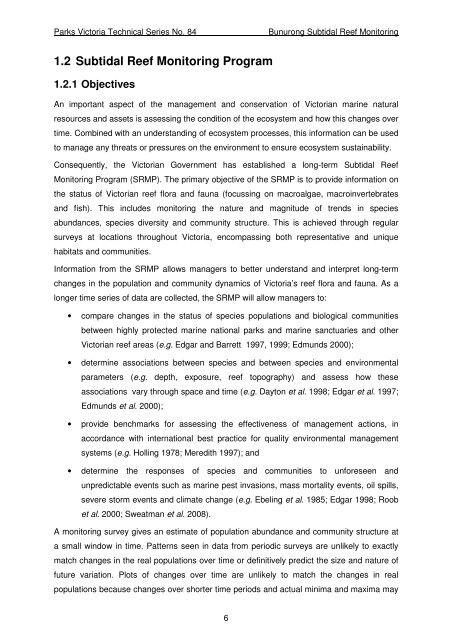the reef biota at bunurong marine national park - Parks Victoria
the reef biota at bunurong marine national park - Parks Victoria
the reef biota at bunurong marine national park - Parks Victoria
Create successful ePaper yourself
Turn your PDF publications into a flip-book with our unique Google optimized e-Paper software.
<strong>Parks</strong> <strong>Victoria</strong> Technical Series No. 84<br />
Bunurong Subtidal Reef Monitoring<br />
1.2 Subtidal Reef Monitoring Program<br />
1.2.1 Objectives<br />
An important aspect of <strong>the</strong> management and conserv<strong>at</strong>ion of <strong>Victoria</strong>n <strong>marine</strong> n<strong>at</strong>ural<br />
resources and assets is assessing <strong>the</strong> condition of <strong>the</strong> ecosystem and how this changes over<br />
time. Combined with an understanding of ecosystem processes, this inform<strong>at</strong>ion can be used<br />
to manage any thre<strong>at</strong>s or pressures on <strong>the</strong> environment to ensure ecosystem sustainability.<br />
Consequently, <strong>the</strong> <strong>Victoria</strong>n Government has established a long-term Subtidal Reef<br />
Monitoring Program (SRMP). The primary objective of <strong>the</strong> SRMP is to provide inform<strong>at</strong>ion on<br />
<strong>the</strong> st<strong>at</strong>us of <strong>Victoria</strong>n <strong>reef</strong> flora and fauna (focussing on macroalgae, macroinvertebr<strong>at</strong>es<br />
and fish). This includes monitoring <strong>the</strong> n<strong>at</strong>ure and magnitude of trends in species<br />
abundances, species diversity and community structure. This is achieved through regular<br />
surveys <strong>at</strong> loc<strong>at</strong>ions throughout <strong>Victoria</strong>, encompassing both represent<strong>at</strong>ive and unique<br />
habit<strong>at</strong>s and communities.<br />
Inform<strong>at</strong>ion from <strong>the</strong> SRMP allows managers to better understand and interpret long-term<br />
changes in <strong>the</strong> popul<strong>at</strong>ion and community dynamics of <strong>Victoria</strong>’s <strong>reef</strong> flora and fauna. As a<br />
longer time series of d<strong>at</strong>a are collected, <strong>the</strong> SRMP will allow managers to:<br />
• compare changes in <strong>the</strong> st<strong>at</strong>us of species popul<strong>at</strong>ions and biological communities<br />
between highly protected <strong>marine</strong> n<strong>at</strong>ional <strong>park</strong>s and <strong>marine</strong> sanctuaries and o<strong>the</strong>r<br />
<strong>Victoria</strong>n <strong>reef</strong> areas (e.g. Edgar and Barrett 1997, 1999; Edmunds 2000);<br />
• determine associ<strong>at</strong>ions between species and between species and environmental<br />
parameters (e.g. depth, exposure, <strong>reef</strong> topography) and assess how <strong>the</strong>se<br />
associ<strong>at</strong>ions vary through space and time (e.g. Dayton et al. 1998; Edgar et al. 1997;<br />
Edmunds et al. 2000);<br />
• provide benchmarks for assessing <strong>the</strong> effectiveness of management actions, in<br />
accordance with intern<strong>at</strong>ional best practice for quality environmental management<br />
systems (e.g. Holling 1978; Meredith 1997); and<br />
• determine <strong>the</strong> responses of species and communities to unforeseen and<br />
unpredictable events such as <strong>marine</strong> pest invasions, mass mortality events, oil spills,<br />
severe storm events and clim<strong>at</strong>e change (e.g. Ebeling et al. 1985; Edgar 1998; Roob<br />
et al. 2000; Swe<strong>at</strong>man et al. 2008).<br />
A monitoring survey gives an estim<strong>at</strong>e of popul<strong>at</strong>ion abundance and community structure <strong>at</strong><br />
a small window in time. P<strong>at</strong>terns seen in d<strong>at</strong>a from periodic surveys are unlikely to exactly<br />
m<strong>at</strong>ch changes in <strong>the</strong> real popul<strong>at</strong>ions over time or definitively predict <strong>the</strong> size and n<strong>at</strong>ure of<br />
future vari<strong>at</strong>ion. Plots of changes over time are unlikely to m<strong>at</strong>ch <strong>the</strong> changes in real<br />
popul<strong>at</strong>ions because changes over shorter time periods and actual minima and maxima may<br />
6

















